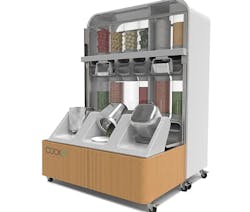Fun Innovations Friday: Labor Shortages Be Damned! Invention of Robotic Chef Turns the Tables
Over the years, I've made a couple of friends who happen to be chefs and one of them has even opened a restaurant that's doing amazing. I'm in awe of the entrepreneurial spirit and the drive for this profession as I see and hear the struggles associated with this career: long hours and no workers.
It's no secret that the past few years have brought about a worker shortage across all types of jobs and the food industry was one of the hardest hit. A lot of loved restaurants closed down after the pandemic and the industry just hasn't been what it once was. With a culture that relies on tips to make it by, the late nights and weekends, and the constant stress—who can blame people for not wanting these jobs? And that's basically just the waiters and waitresses. Line cooks and chefs don't get tips unless a restaurant uses a pooling system where everyone gets a bit of the pot.
Well, in the trend of automating everything, a French start-up named Cook-E has developed a solution to relieve restaurateurs of the pressure of the shortage of skilled workers: a robotic kitchen. This robot chef creates fresh and healthy dishes without human assistance, swinging pots around with little space and not spilling any food.
Cook-e was created to help these restaurants avoid shutting down, relieving the burden of labor shortages. So how exactly does it cook without a staff? Surely there has to be a human component somewhere, right?
So here's how it works: Employees or guests place the order with a tablet, an input terminal or an app. Then, the robot kitchen starts the fully automatic preparation of a customized dish.
Step 1: Assemble ingredients according to the recipe. Metering containers move along a shelf with storage modules. Depending on the menu selected, rice, shredded chicken, corn, and other chopped ingredients are removed with an accuracy of 0.5 grams.
Step 2: Once all ingredients have been collected, the contents are poured into one of three rotating cooking modules that resemble a wok pan. They can rotate and tilt, mix, fry, and stir. In just 210 seconds or 3.5 minutes after ordering, the dish is ready to serve.
According to Cook-e, 250 dishes per hour are possible, including risottos, chili con carne or osso bucco.
"The automation of simple tasks and the associated lower costs allow restaurant owners to invest more in ingredients and service quality to provide a better restaurant experience with consistently high-quality dishes," stated Quentin Guilleus, co-founder Cook-e.
To allow as many restaurants as possible to benefit from automation, Cook-e has designed the robotic kitchen to be space-saving. Rental prices are high, and kitchens are correspondingly small, especially in major cities. Therefore, all components are compact, from ingredient storage modules to dosing container positioning mechanics.
Additionally, the robotic kitchen's components must meet the strict hygienic requirements of HACCP, a hygiene concept that NASA developed initially to ensure food safety for astronauts.
"The materials chosen, mainly stainless steel and PETG, are suitable for contact with food," says Guilleus.
External greases and lubricants have been eliminated, so all bearing points and surfaces are hygienic, extremely easy to clean, and quick to make ready for use again. This is important because the kitchen automatically cleans itself after every meal prepared, which involves the dosing containers and pan tilting downwards. A high-pressure water jet with cleaning agents performs the actual cleaning.
I suspect this invention will eventually make its way over to the States and while I don't believe this invention can replace higher-end restaurants, I do think it's a decent solution for fast or casual chains that are struggling with labor shortages. Time will tell.
Fun Innovations Friday
Created by the editors of New Equipment Digest and Plant Services, Fun Innovations Friday is a feel-good blog that showcases how advances in science, math, engineering, and technology are making our world more whimsical. Here’s another post that is guaranteed to brighten your day.
Itsy, Bitsy, Teenie, Weenie MilliMobile Robot Runs on Light and Radio Waves
What if you could deploy a micro robot no bigger than a coin to investigate issues at your facility and wirelessly transmit data from attached sensors to help you make more informed decisions?
About the Author
Laura Davis
Editor-in-Chief, New Equipment Digest
Laura Davis is the editor in chief of New Equipment Digest (NED), a brand part of the Manufacturing Group at EndeavorB2B. NED covers all products, equipment, solutions, and technology related to the broad scope of manufacturing, from mops and buckets to robots and automation. Laura has been a manufacturing product writer for eight years, knowledgeable about the ins and outs of the industry, along with what readers are looking for when wanting to learn about the latest products on the market.

